ASUS U41JF: Arrandale's Not Dead Yet
by Jarred Walton on March 28, 2011 7:35 PM ESTGeneral Performance – Overclocked Arrandale vs. Sandy Bridge
We’re dealing with a lot of similarly specced laptops in the benchmarks, with a lot of Arrandale + GT 420M/425M choices. For this review, we’ll focus on the two Sandy Bridge laptops we’ve tested, one with quad-core i7-2820QM and the other with a dual-core i5-2415M. The dual-core is a new MacBook Pro, and I can confirm that at least the dual-core i5-2520M laptop I’m testing right now is faster in nearly every benchmark, sometimes by a significant margin, so take the MBP13 numbers with a grain of salt. Then again, i5-2520M has more aggressive Turbo modes and a higher base clock than the 2415M.
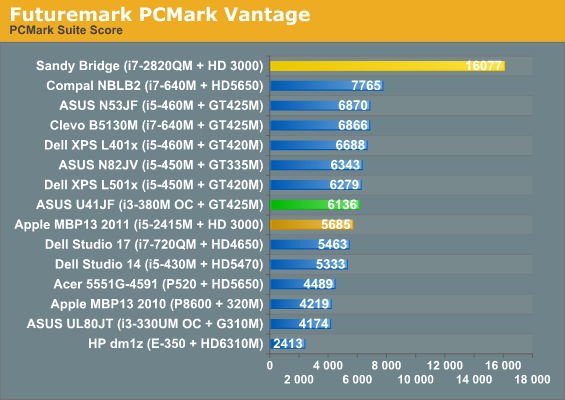
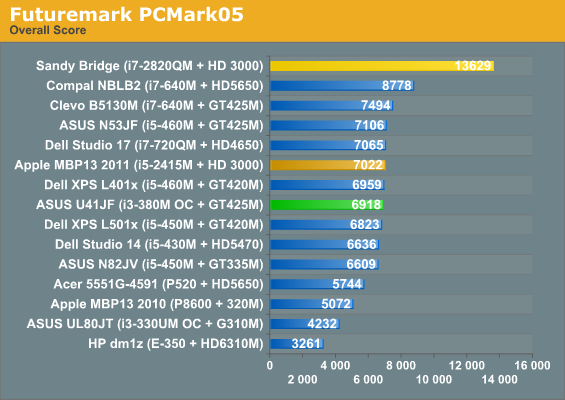
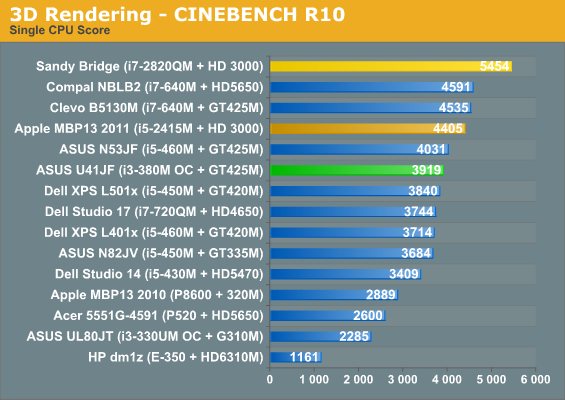
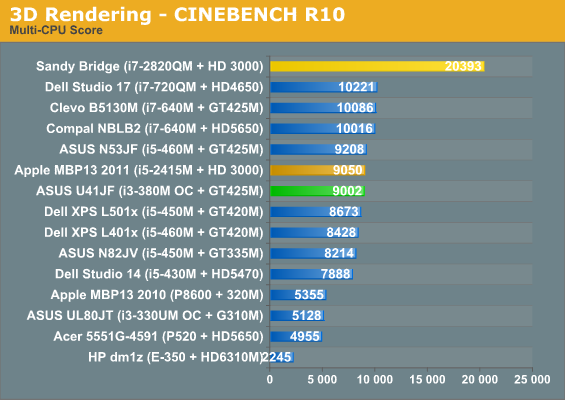

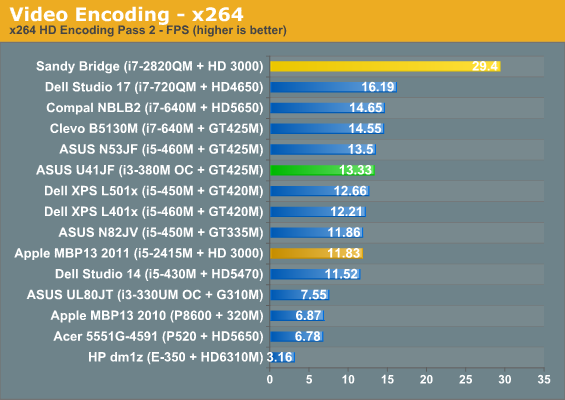
It would help if all of our laptops used the same hard drive (or SSD), because PCMark in particular is highly influenced by that component. As such, the i7-2820QM results in those two tests are largely meaningless since it’s the only system in these charts with an SSD. The remaining tests are much more of a CPU benchmark, though, and here we see the overclocked i3-380M keeping pace with slightly faster Core i5 processors. The MBP13 looks particularly poor in the x264 test, so I’m not entirely sure what’s going on there. Quad-core SNB naturally plays in a different league, often doubling the performance of dual-core Arrandale.
In practice, though, any of the Arrandale laptops is plenty fast for typical use. The one area where dual-core Sandy Bridge really eclipses Arrandale is when you can use Quick Sync to accelerate video transcoding; everything else, it might be 10-30% faster in theory, but in practice that only becomes apparent when you’re running CPU intensive tasks. We’ll be looking at this more in a future review, but for now let’s just say that with a good SSD all of the systems (with the possible exception of the HP dm1z) will handle any task a home user might reasonably run.
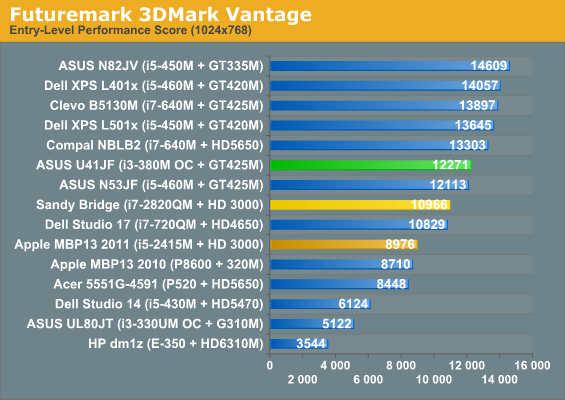
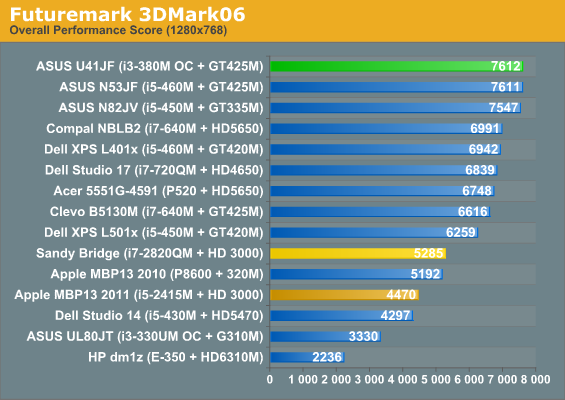
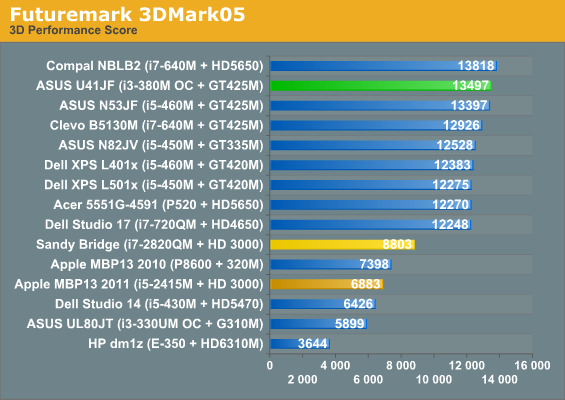
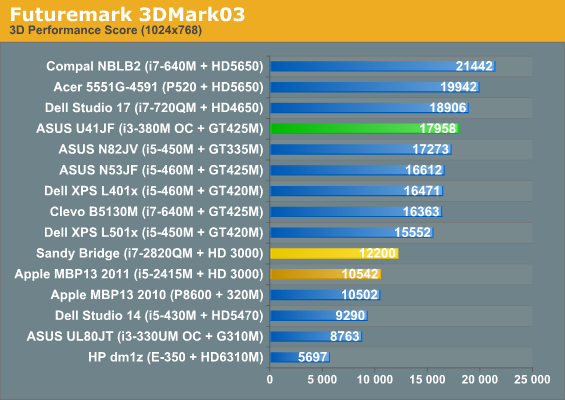
Moving to the 3DMark results, the Vantage Entry-level score is the best showing for SNB, and even there the GT 425M in the U41JF comes out 12% faster than the quad-core and 37% faster than the dual-core. 3D06 and 3D03 come next, with a lead of 44-47% and 70% over the quad- and dual-core SNB. 3D05 gives the GT 425M its biggest wins, with margins of victory of 53% and 96%. Of course, these are all synthetic graphics tests, and while some games might correlate well with 3DMarks, there’s no substitute for benchmarking actual games….










24 Comments
View All Comments
veri745 - Monday, March 28, 2011 - link
Now it's about time that they give the LCDs on these a resolution upgrade. I'd like to see atleast 1600x900jrocks84 - Monday, March 28, 2011 - link
I totally agree on higher resolution LCDs being needed! I haven't searched that hard, but the only two 13" laptops that I know of with a decent res are the Macbook Air and the Sony Vaio Z.lexluthermiester - Tuesday, March 29, 2011 - link
I have a Asus EEE 1201N with 1366x768 res. It beats out my old VIAO which was 1280x800. Now granted, the 1201n is only a dual-core Atom , but at a 12" screen and the fact it will some moderate gaming, it packs punch for it's size. Battery life is far better as well.Of course we are talking about a $400 price point with the 1201n. But I guess the point I'm trying to make is that if you look into what it is you want good things can be found. And honestly, the system in this review would tempt me greatly if the 1201n didn't already meet my needs.... but oh so tempting....
ImSpartacus - Tuesday, March 29, 2011 - link
I agree. I know many laptops will have to move to 16:9 for cost reasons, but why can't they just use 1600x900 as a baseline resolution?768 vertical pixels are unacceptable on anything but 11.6" displays.
blue_falcon - Monday, March 28, 2011 - link
The industry is trending towards industry standard resolutions (HD at the moment for most systems). I doubt you'll see a 1600x900 13.3 screen.Penti - Monday, March 28, 2011 - link
Sony still has some, 13.1" 1600x900 laptops that is. Let's see if they get updated to Sandy Bridge too. If you want it you can have it, even though most use standard displays.DLimmer - Monday, March 28, 2011 - link
As usual, excellent laptop review. I relied on http://www.anandtech.com/show/2862/dell-studio-14z... a couple years ago when I bought my wife's laptop, and it still does all she asks of it *and* lasts all day on one charge (with intermittent use).I also grabbed a Gateway P-6831 based on http://www.anandtech.com/show/2490.
Minor typos (first page third to last paragraph):
"One the flipside, ASUS’ Super Hybrid Engine (SHE)" -> *On* the flipside
(page 5, second paragraph from the bottom):
"and it doesn’t need 960 Steam" -> *Stream*
Thank you for providing objective and in-depth reviews we can use when selecting items to purchase.
ImSpartacus - Tuesday, March 29, 2011 - link
I almost bought a 14z instead of my MBP13'09. It was on the thicker side, but had a massive battery and a full voltage processor.Eventually, I had to have that big trackpad and disk drive.
In retrospect the decision was pretty murky.
DLimmer - Tuesday, March 29, 2011 - link
My wife misses the DVD drive occasionally, but we have an external. It's most annoying when you install some software that requires the disc be in the computer to run. Only other time is when she wants to rip a new CD she's bought.All-in-all, giving up the drive for more battery life and less weight was a decent trade-off... however, she wants a drive in her next laptop.
Beenthere - Monday, March 28, 2011 - link
How could you get it more wrong: Asus and Intel. It don't get any worse than that.